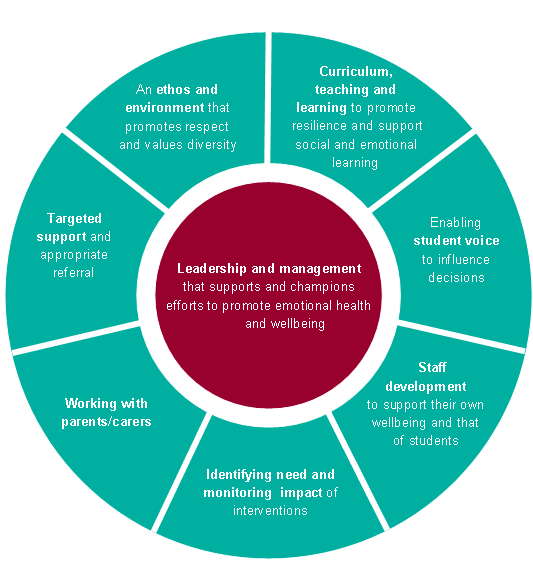Importance of Schools in the Children and Young People’s Mental Health System
- 01 December 2017
- Posted in: Healthcare
We are all increasingly aware of the high prevalence of mental health problems in children and young people. The best data we have suggests that 1 in 10 children and young people, aged 5-16 years have a diagnosable mental disorder.[i] However, this data is from 2004 and there are indicators that this rate has increased, but we won't know for sure until next year when new data will be available.
The majority of children and young people are in educational settings for a considerable amount of their formative years. We know that many children and young people with mental health problems are not accessing specialist mental health services, and would prefer to talk to a trusted teacher if they have a problem. With training and support, teachers and educational settings more generally are in a good position to support the mental health of all pupils, at all ages and all stages. Many schools are doing great work to promote the mental health and wellbeing of their pupils, but it is not universal and is not without difficulties.
"With training and support, teachers and educational settings more generally are in a good position to support the mental health of all pupils."
Teachers do not generally receive any training in mental health and child development, so it can be difficult for them to know whether they are doing the right thing when they are concerned about a child's mental health. We expect the forthcoming Green Paper on children and young people's mental health, to cover schools and mental health in more detail. For instance, the government have already announced that they want to provide teachers with Mental Health First Aid Training.[ii] We hope that the Green Paper will go further than this and look not just at schools, but at the whole children and young people's mental health system.
There are very good reasons for why mental health is important for schools. For instance, there is evidence of the link between pupil health and well-being and attainment.[iii] Academic success has a strong positive impact on a child or young person's subjective sense of how good they feel their life is (life satisfaction) and is linked to higher levels of well-being in adulthood.[iv] In turn, a child or young person's overall level of well-being will impact on their behaviour and engagement in school and their ability to acquire academic competence in the first place. There is evidence that a well-implemented social and emotional learning programme can significantly improve pupils' attainment by eleven percentage points.[v]
Whole School Approach
This is a whole systems approach; and goes beyond learning and teaching in the classroom to pervade all aspects of the life of a school including, importantly, the school's ethos and environment and its partnerships with parents/carers and the wider community.[vi] There is evidence that suggests that a whole school approach is effective in promoting mental health and wellbeing. This approach is included in NICE guidance on promoting mental health in both primary and secondary schools.[vii][viii] It has also been highlighted in a briefing on what works in promoting social and emotional wellbeing in schools.[ix] The policy document, Future in Mind,[x] which puts forward a blueprint for improving children and young people's mental health, encourages all schools to continue to develop whole school approaches to promoting mental health and wellbeing.
A briefing document from Public Health England and the Children and Young People's Mental Health Coalition outlines 8 key principles that make up a whole school/college approach to promoting children and young people's emotional health and wellbeing.[xi]

The diagram above puts leadership and management at the heart of this approach. Their support and input is essential to drive through change in a systematic way. However, the other elements also need to be considered. For instance, it is essential to consider the views and needs of staff, pupils and parents/carers and get their buy in.
"Whatever schools do in terms of promoting mental health and wellbeing, has to work for them, but also be evidence and values based."
Whatever schools do in terms of promoting mental health and wellbeing, has to work for them, but also be evidence and values based. So the challenge for schools is how to implement this. Schools NorthEast are running a schools-led commission on mental health called Healthy MindED.[xii] We are hopeful that findings from this Commission will also be useful for the rest of the country.
Schools have a key role to play in supporting the mental health of their pupils, but they cannot do everything. We need the whole children and young people's mental health system to work well for every child.
[i] Green, H., et al. (2005) Mental health of children and young people in Great Britain 2004. London: Palgrave. http://digital.nhs.uk/catalogue/PUB06116
[ii] Prime Minister's Office (2017) Prime Minister unveils plans to transform mental health support. https://www.gov.uk/government/news/prime-minister-unveils-plans-to-transform-mental-health-support
[iii] Public Health England (2014) The link between pupil health and wellbeing and attainment. London: Public Health England. https://www.gov.uk/government/publications/the-link-between-pupil-health-and-wellbeing-and-attainment
[iv] Chanfreau, J. et al. (2013) Predicting wellbeing. London: NatCen Social Research. http://www.natcen.ac.uk/media/205352/predictors-of-wellbeing.pdf
[v] Durlak, J.A. et al. (2011) The impact of enhancing students' social and emotional learning: a meta-analysis of school-based universal interventions. Child Development, 82 (1), pp. 405-432.
[vi] Langford, R. et al. (2014) The WHO Health Promoting School framework for improving the health and well-being of students and their academic achievement (Review). Cochrane Database of Systematic Reviews 2014, Issue 4. Art. No.: CD008958. DOI: 10.1002/14651858.CD008958.pub2. http://onlinelibrary.wiley.com/doi/10.1002/14651858.CD008958.pub2/pdf
[vii] NICE (2009)Social and emotional wellbeing in secondary education. London: NICE. http://www.nice.org.uk/guidance/ph20
[viii] NICE (2008) Social and emotional wellbeing in primary education. London: NICE. http://www.nice.org.uk/guidance/PH12
[ix] Weare, K. (2015) What works in promoting social and emotional well-being and responding to mental health problems in schools? London: NCB. https://www.ncb.org.uk/sites/default/files/uploads/documents/Health_wellbeing_docs/ncb_framework_for_promoting_well-being_and_responding_to_mental_health_in_schools.pdf
[x] Department of Health & NHS England (2015) Future in Mind: promoting, protecting and improving our children and young people's mental health and wellbeing. London: Department of Health. https://www.gov.uk/government/publications/improving-mental-health-services-for-young-people
[xi] Public Health England & Children and Young People's Mental Health Coalition (2015) Promoting children and young people's emotional health and wellbeing: a whole school and college approach. London: Public Health England. https://www.gov.uk/government/publications/promoting-children-and-young-peoples-emotional-health-and-wellbeing
[xii] Schools NorthEast (2017) First school-led mental health commission launches in North East. http://www.schoolsnortheast.com/news-and-events/article/first-school-led-mental-health-commission-launches-in-north-east/



